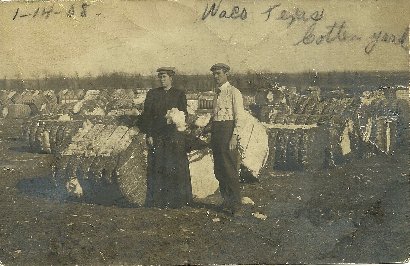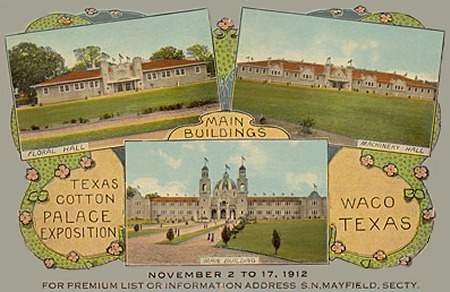|
|
The
State Fair is a Texas institution, but during the first three decades
of the 20th century, millions of people headed to the big doings in
Waco
each fall, not Dallas.
Now practically forgotten, the Cotton Palace rivaled the State Fair
and showcased Waco
for the world up until 1930.
The wife of a Waco
lawyer-a later history identifies here only as Mrs. Joe Taylor-may
have been the first person to articulate the idea of an event highlighting
the cotton industry.
"Why not a Cotton Place at Waco,
the Queen City of the Brazos?" she asked in a Waco
newspaper on Jan. 23, 1890.
Mrs. Taylor and others had heard of a successful annual fair in Nebraska
called the Corn Palace and thought the concept would work in Texas.
Nebraska had plenty of corn, and Texas, especially Waco,
had plenty of cotton. In fact,
the fast-growing McLennan
County city on the Brazos River (it nearly doubled in population
from 1880 to 1890) was the largest inland cotton market in Texas and
one of the largest in the South. Some 120,000 bales of cotton were
sold in the city in 1893. |
 |
It
took the Cotton Palace idea only slightly longer to germinate than
a good cotton crop. With an organizational structure in place by early
1894, plans were drawn for a palatial exhibition hall in Waco's
Padgitt Park. The all-frame building would be 400 feet long and 300
feet across, with eight flagstaff-topped square towers at its corners
surrounding a taller central dome. Waco businessmen raised $250,000
to pay for its construction.
The fair opened November 8 that year and ran until December 6. Gov.
James Stephen Hogg came up from Austin
for the inaugural ceremonies.
"Crowds lined the streets and Waco's first great undertaking, bidding
for national prominence, started off with a whirr, hurrah and every
accompaniment of a great jubilee," the Austin Statesman reported.
As hoped for by Waco civic leaders, the whole nation took note of
the Cotton Palace.
"The mammoth Texas cotton palace was recently thrown open to the public…,"
the Wichita, KS Beacon noted, "and cotton
now reigns as king in the Lone Star State. He is rather a cheap king
just now and is doing business on a 5 cent [per pound] basis, but
nevertheless thousands of his subjects are flocking to Waco
daily to see him."
Even the highly opinionated journalist-orator William Cowper Brann
liked the Cotton Palace. Brann, who later moved to Waco
and gained national recognition with his often acerbic monthly "Brann's
Iconoclast," told the Galveston News he wished the palace could be
placed on wheels and displayed across the nation, especially New England.
"I supposed it was simply to be an exhibit of cotton
and cotton products, but I find that it is to be an exposition on
a colossal scale," he said. "The decorations alone are worth crossing
the state to see. I found nothing so unique at the [1893 Chicago]
world's fair."
The 1894 fair might have been the beginning of a long run except
for what happened on Jan. 19, 1895: The ornate structure, a
model of excessive Victorian architecture, caught fire and burned
to the ground as "ten thousand Wacoans watched and wept."
Despite
the success of the first exposition, it took another 15 years for
the Cotton Palace to bloom again. This time, with an even fancier
and much larger new palace and numerous other buildings covering a
12-acre site in Padgitt Park, the fair took root. |
 |
"Texas
Cotton Palace Exposition, Waco,
Texas, November 2-17, 1912"
Postcard
courtesy www.rootsweb.com/ %7Etxpstcrd/ |
Beginning in
1910, the fair ran every fall for the next 21 years, becoming one
of the most successful such events in the nation. Attendance grew
with the extent of events. In 1912, former Waco mayor Robert Ross,
an old Indian fighter and Civil War veteran, brought a delegation
of Huaco Indians to the fair from Oklahoma. The Indians set up their
tepees on the fair grounds and performed dances on a regular schedule
each day.
During World War I, with
10,000 soldiers at Waco's Camp MacArthur, the military offered sham
battles and warplane flyovers. All time record one-day attendance
came on Nov. 3, 1923, when 117,208 visited the fair. |
Camp MacArthur,
Waco Texas
1918
Postcard
courtesy www.rootsweb.com/ %7Etxpstcrd/ |
|
The coronation
of the Cotton King and Queen was the city's premier social event.
The
annual Cotton Palace festivities went on until 1930, when the Depression
wilted the cotton market and most other aspects of the nation's
economy. The fair closed on Oct. 19 that year for the final time.
An estimated 8 million people had visited the exposition during
its 21-year existence.
World
War II revitalized the state and nation's economy-Waco became
the largest producer of military tents during the conflict-but the
city's importance as a cotton center declined again after the war
and the Cotton Palace was history. The only physical reminder of
the fair in Waco
is a monument in Cameron Park made from the cornerstone of the old
palace. But the Cotton Palace lives on in memory with the annual
Cotton Palace Pageant, which began in 1970.
|
|
|
